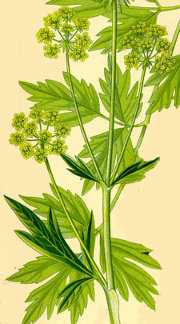 Levisticum officinale
Levisticum officinaleLovage Malignant spirits in Roumania were kept away from the home by hanging either lovage or wormwood on the door or window. Because of its name, which is sometimes transformed into "love-ache," lovage has been used for love charms. Its root is also often combined with other roots, like High John and Queen Elizabeth root, in mojo bags. The root is boiled and the resulting tea added to a bath for love; such a bath is indulged in for 9 days in a row for greatest effectiveness. Culpeper considered this a Sun herb ruled by Taurus. It is a warming herb, and a big one, with yellowish flowers. However, it has a camphorous (Moon) quality to its scent as well, so consider this an herb with some planetary complexity. Top
Mundane Uses
The taste has been described as a combination of celery and angelica. Greeks
and Romans used the leaves, seeds, and roots in cooking. The leaves
and young stalks are nice for flavoring soups, vinegar,
and pickles and have been added to tomato sauce. Seeds can be crushed
and added to baked goods. Young stalks and leaves are sometimes
crystalized like angelica. Roots are peeled before eating, as the
root skin is bitter. Grieve says that together with yarrow and tansy,
lovage was the basis of an English cordial that bears its name,
but we found a couple of other recipes for lovage cordial. One from
1818 listed lovage, valerian, sweet fennel, celery, caraway, and
savin(!); another from 1865 didn't even include any lovage: celery,
cinnamon, mace, and caraway. Whatever the ingredients, lovage cordial
was usually mixed with brandy rather than drunk straight. Medicinally,
this herb is good for the digestion, especially in cases of colic
(pain that moves around the body), and it is a diuretic. An
1881 herbal described a lovage infusion as good for "hysteria
and nervous affections." Another herbal (Botanicum officinale
by Joseph Miller, 1722) describes it as a heating and drying herb
that warms and comforts the stomach and expels "Wind."
You can make straws from the stalks. Top
How to Grow Lovage
Sow in fall or spring to germinate in 10-14 days at room temperature. You can
sow directly in the ground or start from transplants. Set out in
full sun or partial shade. Lovage gets 48-78"/125-200cm tall
and should be spaced 18-24"/45-60cm apart. This perennial
herb is hardy to zone 4. It usually flowers its second year, and
the blossoms draw bees and other good bugs. In the past, the stalks
of this plant were blanched like celery by either mounding up soil
around them or by wrapping the lower part of the plant with paper.
General
growing info Top
Levisticum officinale
Lovage
50 seeds $3.25
Uses in Witchcraft & Magic:
Protection
Love Charms
Sun Herb
© 2010-2024 Alchemy Works; No reproduction without permission
Lovage
vinegar (1914)
2 oz. peeled lovage root
1
oz. lovage seeds
10 oz. vinegar
Digest (let sit in warm place)
for one week & filter.